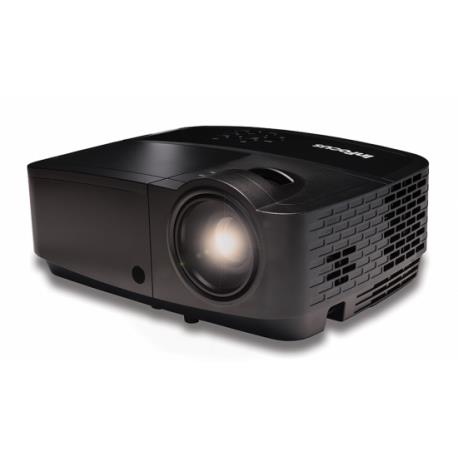
One of the factors buyers must consider when choosing a new projector is the throw capabilities. This refers to the distance between the projector and the screen needed to get the right size image. A simple equation to find this is screen width x throw ratio = throw distance.
Here’s an example: If the projector screen is 10 feet wide and the throw ratio of the projector is 1.8:1, then the projector needs to be placed 18 feet away. 10 x 1.8 = 18. However, when deciding on a throw ratio for the projector, buyers must look at the screen size and how far away the projector is likely to be placed. In this instance they would take the throw distance and divide by the screen size to determine the throw ratio needed in a projector.
Room sizes vary considerably, and not every projector can be placed 18 feet away from the screen. This is why there are short throw and long throw projectors. The primary difference between these projectors is the type of lens included. Short throw projectors generally have a non-zoom, curved lens, while most long throw projectors have standard zoom lenses.
Short Throw Projectors
A projector with a ratio less than 1:1 is considered short throw. There are also ultra-short throw projectors which have a throw ratio of less than 0.4. Ultra-short throw projectors have a mirror that the image is projected onto first before it is reflected onto the screen.
Short throw projectors need to be placed less than three feet from the screen. Their ideal distance is 18 in.-2 ft. Ultra-short throw projectors can be placed just 15 inches away from the screen to get a 100 inch image. However, if they are placed back too far, the image will become distorted.
It is recommended to use short throw and ultra-short throw projectors with interactive whiteboards or fixed-frame screens. The shorter throw technologies can amplify any imperfections and waviness of a surface that isn’t completely flat, such as a motorized or pull-down screen.
For the best results short throw projectors should be mounted on a wall. This short distance prevents shadows and keeps the projector light from shining in the presenter’s face while they speak. Short throw projectors allow for presentations and multimedia sharing in classrooms or conference rooms with limited space.
Both short throw and ultra-short throw projectors are more expensive and are used mostly in commercial applications because of their cost.
Long Throw Projectors
Long throw projectors can require six or more feet of distance from the screen to project a 100 inch image. If this type of projector is installed closer than that to the screen, the image will shrink and not reach the edges of the screen.
In larger lecture halls, auditoriums, or conference centers, long distance projectors can project onto a large screen for maximum visibility for everyone in the room. They can also be used with all types of projector screens without amplifying screen ripples.
The main advantage of long throw projectors is that they are more cost-effective than short throw alternatives, but they do have some disadvantages as well. It is easy for the presenter to walk in front of the projected image, disrupting the audience’s view. They’re also subject to a glare on the screen.
AV Superstore has both short throw and long throw projectors available to customers. Visit our website to learn more and chat with the online support for assistance in finding the perfect projector for any size space.
